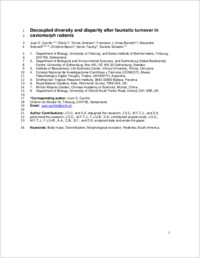Decoupled diversity and disparity after faunistic turnover in caviomorph rodents
DOKPE
- Carrillo, Juan D. University of Fribourg
- Torres Jiménez, María Fernanda Institute of Biosciences, Vilnius University
- Urrea-Barreto, Francisco J Museo Paleontológico Egidio Feruglio
- Antonelli, Alexandre Royal Botanic Gardens, Kew
- Bacon, Christine University of Gothenburg
- Faurby, Søren University of Gothenburg
- Silvestro, Daniele University of Fribourg
-
13.05.2009
English
Understanding the relationship between species diversity and morphological disparity in evolutionary radiations is a major challenge in macroevolution. Caviomorpha diversified in the Americas, and the sister clades Octodontoidea and Chinchilloidea (including spiny rats and chinchillas, respectively) provide a striking example of imbalanced evolution. These clades vary in diversity with 195 extant species in the former and six extant species in the latter. However, fossils document a higher past diversity and disparity in Chinchilloidea, including the largest rodents that ever existed. We combine data from extant and extinct species to evaluate how evolutionary dynamics shaped their contrasting diversity and disparity patterns. We inferred a phylogeny including 149 extant and 52 extinct species, and used craniodental traits and body mass to infer morphological evolution. Our results indicate that the most recent common ancestor of Chinchilloidea and Octodontoidea lived during the late Eocene (~36.5 Ma). The inferred ancestral body mass was small (~187 gr), but grew in range over time in Chinchilloidea. Although rates of morphological evolution in Chinchilloidea were significantly higher than in Octodontoidea, these clades shared similar diversity trajectories until an Oligocene turnover event. Octodontoidea then began increasing diversity until the present, whereas Chinchilloidea diversity stagnated and dropped in the late Miocene and Pleistocene. Neogene and Quaternary extinctions in Chinchilloidea reversed a pattern of relative higher disparity than Octodontoidea that had lasted for ~30 million years. We show a case of remarkable decoupling between diversity and disparity, highlighting complex relationships between ecomorphology, species richness, and how they were affected by extinctions.
- Faculty
- Faculté des sciences et de médecine
- Department
- Département de Biologie
- Language
-
- English
- Classification
- Biological sciences
- License
-
License undefined
- Open access status
- green
- Persistent URL
- https://folia.unifr.ch/unifr/documents/326649
Other files
Statistics
Document views: 215
File downloads:
- carrilloetalcaviomorphs: 173
- appendix3: 57
- appendix1: 53
- appendix2: 58

